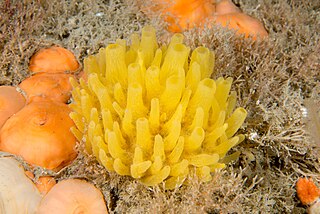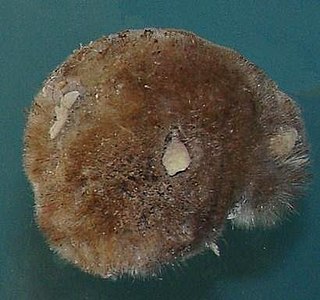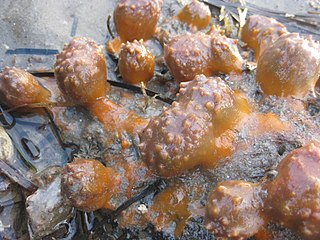
Polymastia is a genus of sea sponges containing about 30 species. These are small to large encrusting or dome-shaped sponges with a smooth surface having many teat-shaped projections (papillae). In areas of strong wave action, this genus does not grow the teat structures, but instead grows in a corrugated form.
Dame Patricia Rose Bergquist was a New Zealand zoologist who specialised in anatomy and taxonomy. At the time of her death, she was professor emerita of zoology and honorary professor of anatomy with radiology at the University of Auckland.

Polymastiidae is a family of demosponges found in oceans throughout the world. It is the only family in the monotypic order Polymastiida. A useful diagnostic characteristic of members of this family is the presence of numerous surface papillae although this feature is shown by some other sponges.
Tylexocladus is a genus of deep-water sea sponge belonging to the family Polymastiidae. These are small rounded sponges with a bristly surface bearing one or more raised openings.
Acanthopolymastia is a small genus of demosponges belonging to the family Polymastiidae. It has three describe species. These small, bristly, cushion-shaped sponges are only known from deep-sea sites in the southern oceans.
Proteleia tapetum is a species of sea sponge belonging to the family Polymastiidae. It is found in shallow subtidal and intertidal habitats in the far north of North Island, New Zealand.
Polymastia lorum is a species of sea sponge belonging to the family Polymastiidae. It is only known from a single specimen found attached to a dead Glycimeris valve on a reef near Ohinau Island, one of the Mercury Islands off North Island, New Zealand.
Polymastia echinus is a species of sea sponge belonging to the family Polymastiidae. It is only known from shallow subtidal habitats off Te Hāwere-a-Maki / Goat Island in the north of the North Island of New Zealand.
Polymastia crocea is a species of sea sponge belonging to the family Polymastiidae. It is found in subtidal habitats below 6 m depth in the far north of the North Island of New Zealand.
Polymastia aurantia is a species of sea sponge belonging to the family Polymastiidae. It is found in intertidal habitats including tide pools in the vicinity of Auckland, New Zealand.
Polymastia pepo is a species of sea sponge belonging to the family Polymastiidae. It is a common species of rocky subtidal and intertidal habitats in the far north of North Island, New Zealand.
Polymastia hirsuta is a species of sea sponge belonging to the family Polymastiidae. It is found in various subtidal habitats in the far north of North Island, New Zealand.
Atergia villosa is a species of sea sponge belonging to the family Polymastiidae. It is found in rocky deep-sea habitats around the Chatham Islands, New Zealand.
Acanthopolymastia acanthoxa is a species of sea sponge belonging to the family Polymastiidae. It is a deep-ocean species found on muddy substrates at depths of over 3000 m in the Ross Sea, Antarctica.

Aaptos is a genus of sea sponges in the family Suberitidae.
Aaptos conferta is a species of sea sponge belonging to the family Suberitidae and is found in New Zealand. The species was described in 1994 by Michelle Kelly-Borges & Patricia Bergquist.
Aaptos rosacea is a species of sea sponge belonging to the family Suberitidae. The species was described in 1994 by Michelle Kelly-Borges & Patricia Bergquist.

Aaptos tenta is a species of sea sponge belonging to the family Suberitidae. The species was described in 1994 by Michelle Kelly-Borges and Patricia Bergquist.

Aaptos lobata is a species of sea sponge belonging to the family Suberitidae. The species was described in 2017. The holotype was collected in the Makassar Strait.
Michelle Kelly, also known as Michelle Kelly-Borges, is a New Zealand scientist who specialises in sponges, their chemistry, their evolution, taxonomy, systematics, and ecology.




